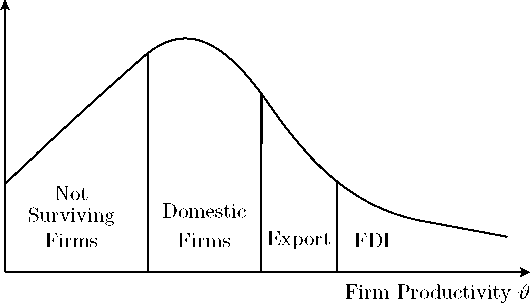Uncertain Productivity Growth
1 INTRODUCTION
Probability
Density

Figure 1: Firm distribution and productivity
distribution is a result of a lottery in which firms experience their final productivity level after
paying the market entry costs. The model has been tested in various empirical works (Girma
et al., 2005; Wagner, 2006), and its core predictions are well reflected in the data (Helpman,
2006). Helpman et al. (2004) e.g. analyze U.S. exports and affiliate data based on a Pareto
distribution for ex ante uncertainty, covering 38 countries and 52 manufacturing sectors and are
able to identify the significance of the relationship between productivity and the mode of serving
a new foreign market. The New New Trade Theory emphasizes that the firm distribution within
an industry is not a random sample. In steady-state, productivity turns out to be an appropriate
variable to explain the selection effects within an industry. However, within this new workhorse
theory it is difficult to derive transition predictions, especially on how the firms select their mar-
ket entry mode. Helpman et al. (2004) introduce productivity uncertainty as a one-time shock
effect which determines the final firm distribution.
On the other hand, from a microeconomic perspective, firms base their market entry decision on
intertemporal profit maximization. Within this optimization calculus, productivity uncertainty
is not considered as a one time exogenous phenomenon but as a continuous aspect.
Faggio et al. (2007) e.g. present empirical data about the development of total factor productivity
(TFP) for different sectors and for the whole economy in the U.K., starting in 1984. The authors
show that besides a steady growth of TFP in the last decade, furthermore productivity dispersion
in different sectors has increased. Bloom et al. 2007 show additionally that firm productivity
exhibits a steady but volatile growth over time.
Given these insights, decision makers posses at least an expectation about their intertemporal
productivity development in their home and foreign country. Based on historical experiences or
More intriguing information
1. Financial Markets and International Risk Sharing2. The name is absent
3. The name is absent
4. The name is absent
5. Critical Race Theory and Education: Racism and antiracism in educational theory and praxis David Gillborn*
6. Ex post analysis of the regional impacts of major infrastructure: the Channel Tunnel 10 years on.
7. The name is absent
8. The name is absent
9. Shifting Identities and Blurring Boundaries: The Emergence of Third Space Professionals in UK Higher Education
10. The name is absent